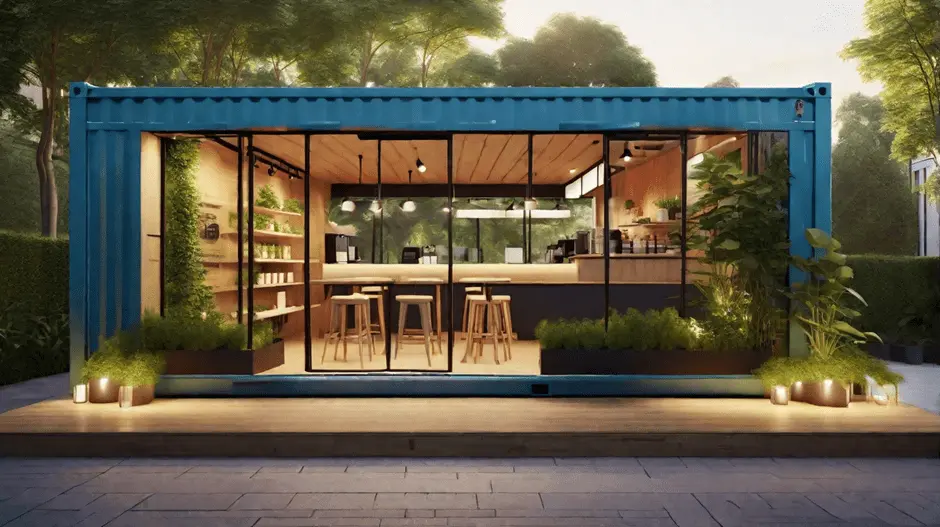Introduction

Shipping containers This comprehensive guide will walk you through the entire process of creating a container house from shipping containers, from initial planning to final touches. We’ll also explore why modular containers, cargo container homes, and container cabins are gaining popularity among entrepreneurs and creative professionals
What Is a Container House?
A container house is a structure made from repurposed shipping containers. Originally designed for transporting goods across oceans, these steel boxes are now being transformed into stylish, functional buildings — from tiny homes to commercial offices.
Their durability, affordability, and environmental benefits make them an ideal choice for small business owners who want to build quickly without compromising quality or sustainability.
Why Choose a Container House?
Before diving into the how-to, let’s explore the top reasons why shipping container homes are becoming a go-to solution:
1. Eco-Friendly & Sustainable
Repurposing old containers reduces waste and gives new life to materials that would otherwise sit in landfills. This aligns perfectly with the values of many modern businesses aiming to reduce their carbon footprint.
2. Cost-Effective Building Option
Compared to traditional construction methods, building with containers is significantly more affordable. You save on materials, labor (if opting for DIY), and often enjoy faster build times.
3. Durable & Weather-Resistant
Shipping containers are built to withstand extreme weather conditions and heavy loads during transport. This makes them incredibly resilient when used for housing or workspaces.
4. Modular & Customizable
Thanks to their uniform size and modular design, multiple containers can be stacked or arranged side-by-side to create larger, more complex structures like modular container houses or multi-unit cargo container homes
5. Quick to Build
With fewer materials and simpler designs, container cabins and homes can be completed in weeks rather than months, perfect for small business owners needing quick setup.Step-by-Step Guide: How to Build a Container House Ready to start your project? Here's a clear roadmap to help you turn a steel box into a stylish, functional space.
Step 1: Define Your Purpose and Plan Carefully
Ask yourself: Will this be a home office, a retail kiosk, a guest cabin, or a studio space How much square footage do I need? Sketch a rough layout and determine how many containers you'll need. Standard sizes are 20-foot and 40-foot containers.
Tip:Start small and expand later using additional modules — that’s the beauty
Step 2: Check Local Zoning Laws and Permits
Before purchasing a container, research local zoning laws, building codes, and permit requirements. Some areas may restrict where you can place a shipping container home, especially if it's intended for permanent residence or commercial use.
Pro Tip: Contact your city or county building department to ensure compliance and avoid costly delays
Step 3: Source Your Shipping Container
You can purchase new or used containers from local suppliers or online marketplaces. Used containers are cheaper, but inspect them carefully for rust, dents, or damage.
Common types include:
- Standard Dry Containers
- High Cube Containers (extra height)
- Open Top or Side Open Containers (for unique designs)
Step 4: Design Your Container House
Work with an architect or contractor experienced in container cabins and cargo container homes to finalize your plans. Key considerations include:
- Placement of doors and windows
- Interior layout and flow
- Electrical and plumbing locations
- Ventilation and insulation needs
- Design Idea: Combine two or more containers at right angles to create L-shaped or T-shaped
- layouts for added space and visual appeal.
Step 5: Prepare the Site and Foundation
Choose a flat, stable location for your house. Clear the site and install a proper foundation. Options include:
- Concrete slab
- Piers or footings
- Concrete blocks
- A solid foundation ensures longevity and stability, especially if you plan to stack containers.
Step 6: Modify and Assemble the Container
Once the site is ready, it’s time to modify your container:
- Cut openings for doors and windows (or pre-cut containers)
- Sandblast and prime the exterior
- Paint with rust-resistant paint
- Join multiple containers using welding or bolts
- If you’re not confident in doing this yourself, hire a professional welder or builder familiar with shipping container homes.
Step 7: Insulate and Climate Control
- Metal conducts heat and cold easily, so insulation is critical. Popular options include:
- Spray foam insulation (best for sealing gaps)
- Rigid foam boards
- Fiberglass batts
- Also, install HVAC systems, ceiling fans, or radiant floor heating to maintain comfort year-round.
Step 8: Install Utilities and Interior Finishes
Hire licensed electricians and plumbers to:
- Run electrical wiring and outlets
- Set up lighting and switches
- Connect water lines and drains (if applicable)
For interiors:
- Add drywall or wood paneling
- Install flooring (vinyl, laminate, or hardwood)
- Finish walls with paint or wallpaper
Step 9: Final Touches and Furnishing
Personalize your space with:
- Furniture suited to the space
- Decorative lighting and art
- Smart storage solutions
- Consider adding foldable furniture, sliding doors, or vertical gardens to maximize space in smaller container cabins.
Step 10: Landscape and Outdoor Enhancements
- Create an inviting outdoor area by
- Adding patios or decks
- Installing planters or raised beds
- Setting up outdoor seating or meeting areass
- This is especially valuable for small business owners who host clients or need a peaceful workspace outdoors.
Types of Container Houses for Small Businesses
1. Modular Container House
Ideal for growing businesses that need scalable spaces. Modular units can be added or reconfigured as needed.
2. Cargo Container Homes
Great for semi-permanent or remote operations — think field offices, retreat centers, or pop-up stores
3. Container Cabins
Perfect for vacation rentals, Airbnb setups, or personal getaways. Can be fully equipped with bathrooms, kitchens, and sleeping quarters
Conclusion: Build Smart with Container Houses
Building a container house out of shipping containers isn’t just about saving money — it’s about embracing innovation, sustainability, and flexibility. For small business owners, it opens the door to creating unique, branded spaces that stand out while staying within budget. So, take the first step today. Research, plan, and start transforming those steel boxes into something extraordinary. Your dream space — and business environment — could be just one container away.
GGR Enterprises is your leading provider of container houses, shipping container homes, modular container houses, cargo container homes, and container cabins in Chennai and across India. We offer fully customizable, eco-friendly, and durable solutions for residential, commercial, and industrial use. For more details about our products and services, visit GGR
FAQ
Q1: What is a container house made of? ▼
It’s typically made from repurposed shipping containers, which are converted into living or working spaces with proper modifications like insulation, windows, doors, and interior finishes.
Q2: Are container houses safe and durable? ▼
Yes, these are extremely durable due to the strong steel structure of shipping containers. When properly insulated and maintained, they can last over 25–30 years. .
Q3: How long does it take to build a container house? ▼
Depending on the complexity and customization, it can be built in 4 to 12 weeks, which is much faster than traditional construction
Q4: Can I live permanently in a container house? ▼
Yes, you can be designed for permanent living. They require proper insulation, plumbing, electricity, and adherence to local building codes
Q5: Are container houses eco-friendly? ▼
Yes, these are considered eco-friendly because they reuse existing materials, reducing construction waste and promoting sustainability
